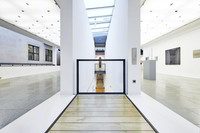End from a colorfully woven clavus without the oval end piece. The fundamental (frame) pattern is woven in blue, the further areas resp. fields are yellow, white and red.
The Coptic textiles that are obtained in the Museum Ulm were acquired by the former Gewerbemuseum Ulm (Museum of Applied Arts) from the collection of Franz Bock (1823 - 1899) in the end of the 1880s. Dr. Franz Johann Joseph Bock was a cleric and art historian and travelled in 1885 and 1886 to Upper Egypt where he carried out excavations. In this manner, he set up a collection of Coptic textile fragments that come from graves. Particularly these are parts of blankets or tunics. The collected objects Franz Bock has sold gradually to different museums. Since Bock has cut his finds, normally only fragments from larger fabrics came into the different collections. Thereby it is likely that snippets from one and the same textile can be found dispersed on several collections.
en

